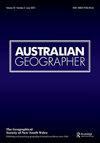Kosciuszko National Park, Brumbies, law and ecological justice
IF 2
2区 社会学
Q2 GEOGRAPHY
引用次数: 1
Abstract
ABSTRACT The brumby (or feral horse) is an icon of colonial settler Australian culture in the Snowy Mountains region of New South Wales (NSW), Australia. 2018 saw the introduction of the Kosciuszko Wild Horse Heritage Bill 2018 (NSW), known as the Brumbies Bill, which cast heritage protections over brumbies in Kosciuszko National Park (KNP). The Brumbies Bill prioritised feral horses over the protection of Alpine Australia, an area which contains a unique ecosystem only present on 0.3% of the Australian landmass. The Bill was highly controversial and directly undermined decades of research into feral horse damage by overturning the pre-existing KNP Horse Management Plan. In this paper we explain the change of policy, an undertaking especially important in the context of debates about the need for more biodiversity protection. We apply a critical legal geography lens, focused on the need to understand how law/s shape places, draw on ideas from ecological justice and introduce the principle of non-regression to this controversial policy reversal. We are especially interested in exposing the processes behind such environmental policy reversals and in unpacking competing perspectives regarding policy formation. We suggest abrupt policy changes are not prudent for a precautionary approach to environmental protection.科希丘什科国家公园、布鲁姆比斯、法律和生态正义
摘要野马是澳大利亚新南威尔士州雪山地区殖民地定居者澳大利亚文化的象征。2018年出台了《2018年科希丘什科野马遗产法案》(新南威尔士州),即《布鲁姆比斯法案》,该法案对科希丘什科国家公园(KNP)的布鲁姆比斯进行了遗产保护。布鲁姆比斯法案将野马置于澳大利亚阿尔卑斯山的保护之上,该地区拥有独特的生态系统,仅占澳大利亚陆地面积的0.3%。该法案极具争议,推翻了先前存在的KNP马匹管理计划,直接破坏了数十年来对野马损伤的研究。在这篇论文中,我们解释了政策的变化,这在关于需要更多生物多样性保护的辩论中尤为重要。我们运用了批判性的法律地理学视角,重点关注了解法律如何塑造地方的必要性,借鉴生态正义的思想,并在这一有争议的政策逆转中引入不倒退原则。我们特别感兴趣的是揭露这种环境政策逆转背后的过程,并揭示关于政策形成的相互竞争的观点。我们认为,突然的政策变化对于预防性的环境保护方法来说是不谨慎的。
本文章由计算机程序翻译,如有差异,请以英文原文为准。
求助全文
约1分钟内获得全文
求助全文
来源期刊

Australian Geographer
GEOGRAPHY-
CiteScore
4.10
自引率
8.30%
发文量
33
期刊介绍:
Australian Geographer was founded in 1928 and is the nation"s oldest geographical journal. It is a high standard, refereed general geography journal covering all aspects of the discipline, both human and physical. While papers concerning any aspect of geography are considered for publication, the journal focuses primarily on two areas of research: •Australia and its world region, including developments, issues and policies in Australia, the western Pacific, the Indian Ocean, Asia and Antarctica. •Environmental studies, particularly the biophysical environment and human interaction with it.
 求助内容:
求助内容: 应助结果提醒方式:
应助结果提醒方式:


